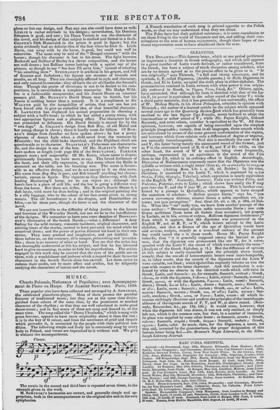GLEANINGS.
THE DIGAMMA.—ThiS famous letter, which at one period performed so important a function in Greek orthography, and which still appears in a great number of Latin words derived, or rather transferred, from. the Greek, has been a subject of much discussion among scholars, who are by no means agreed as to the precise effect to be given to it. " It was originally," says Thiersch, " a full and strong consonant, and its symbols, r, F, called Digamma, (double gamma,) or /Colic Digamma in Greek, and Ef in Latin, occupied the sixth place in either alphabet. The pronunciation retained in Latin evinces with what power it was origin. ally endowed in Greek, in Now, Fieros,'Fas4 ltc." Others, again, have contended, that although its form is identical with that of the La- tin F, its power is equivalent to the softer sound of the letter V; while a third party maintain, that it has generally, if not universally, the effect of W. Bishop Marsh, in his Hors Pelasgice, coincides in opinion with Thiersch ; the author of a learned article on the subject which appeared several years ago in the Quarterly Review,[and which has generally been ascribed to the late Signor Ugo Foscolo' seems inclined to adopt the intermediate or softer sound of V; while Mr. Payne Knight, Colonel Kennedy, and some others, consider it equivalent to the W. All these opinions, however, are capable of being reconciled upon the simplest principle imaginable ; namely, that in all languages, those sounds which are articulated by means of the same general conformation of the organs, and between which there subsists only a difference of degree or impetus, are mutually interchangeable. Now this is manifestly the case with F and V, the latter being merely the attenuated sound of the former, just as P is the attenuated sound of B, G of K, and T of D; while, on the other hand, the sound of 'W is variable, being more frequently, perhaps, represented by an equivalent to the sound of the Vats than to the Uh, which is its ordinary effect in English. Accordingly, Dionysius of Halicarnassus expresssly states that the Digamma was the syllable on written with a single letter (thus a), ,1411, 01/ OUXA.Zg;11/ EV; CTOIXSI, Ve4001LiVnY• (Antiqq. Rom. Lib. i. p. 52, ed. Reiske.) In his time, therefore, it answered to the Latin V, which is expressed by au (as 0?,sx;es' Velia, ObccAtelos, Valerius), which expression is nearly equivalent to the English W. Anciently, however, Velia was written Felia, and Valerius, Falerius, even in Latin ; which shows how easily the F may pass into the V, and the V into W, or vice versa. This is further con- firmed by a passage in Quintilian, which appears to have escaped the attention of scholars: " /Eolicm quoque literm," says he, "qua servunt cervunique dicimus, etiamsi forma a nobis repudiate est, via, tamen nos ipsa persequitur." Inst. Orat. lib. xii. c. 10, p. 504, ed Rol. lin. What this "vis" really was, we learn from another passage of the same author : " Desuntque engine nobis necessarim• non cum Grmca scribimus (turn enim ab iisdem duas inutamur), used proprie in Latinis, us in his, serous et vulgus, Aolicum digamma desideratur ;" from which it appears, that the digamma was pronounced as the English W, not as B, F, or V, which letters existed in the Latin alphabet, and that a Roman of the age of Quintilian would have said serwus, wulgus, exactly as a true-bred cockney of the present day would sound the v in these words. Hence Mr. Payne Knight remarks, that "it is generally supposed among the learned at pre- sent, that the digamma was pronounced like our W, for it corre- sponded with the Latin V, the sound of which was certainly the same." (Analysis of the Greek Alphabet, p. 11.) But the difference of opinion on this subject is easily reconciled upon the principle above stated, namely, that the souads of homo-organic letters were interchangeable, or, in other words, that the sounds of the digamma and the Latin V were variable, not fixed ; which Quintilian expressly informs us was the case with respect to the latter character. And this conclusion is con- firmed by what we observe in the identical words which still exist in Greek, Latin, and Sanscrit as, for example, Sanscrit, widanti ; Greek, sAss,re., or with the digamma, FJosrar ; Latin, vident: Sanscrit, warnati ; Greek, sissrai, or with the digamma, F:savrai ; Latin, vomit: Sanscrit, diwan ; Greek, hap or Um, ; Latin, divurn : Sanscrit, awirz ; Greek, mu or Rip ; Latin, ovem ; Sanscrit ; navamt ; Greek, vavv, or resFyv ; Latin, nevem: Sanscrit, nawain ; Greek, VEG7, or 'Env; Latin, nouurn : San- salt, wacham ; Greek, demos or Forms.; Latin, vocem : all which in- stances strikingly illustrate and confirm the principles of the interchange. ableness of the cognate sounds of F, V, and W, as above stated. (Ken- nedy, Researches, &c., pp. 134, 135.) It would seem, however, that when the digamma fell into disuse, it was not only omitted, or simply left out, which is the common case, but that, in a number of instances, its place was supplied by some other letter : as Sanscrit, seweta ; Greek, 01AETTC Sanscrit, wagmi ; Greek, Anyisa Sanscrit, wahate ; Greek, szsmal ; Latin, veldt. So much, then, for the Digamma, a name, we may add, invented by the grammarians, the proper designation of this famous letter being BaiL—Dr. Browne's Nuge Literarie, in the Edin. burgh Literary Journal.


























 Previous page
Previous page